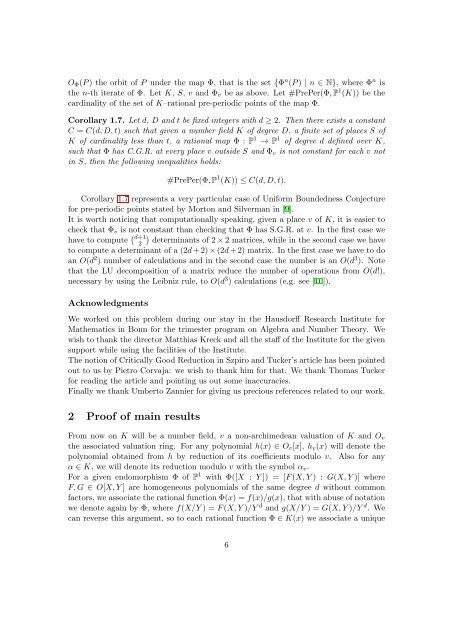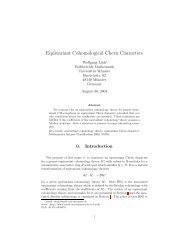On some notions of good reduction for endomorphisms of the ...
On some notions of good reduction for endomorphisms of the ...
On some notions of good reduction for endomorphisms of the ...
Create successful ePaper yourself
Turn your PDF publications into a flip-book with our unique Google optimized e-Paper software.
O Φ (P ) <strong>the</strong> orbit <strong>of</strong> P under <strong>the</strong> map Φ, that is <strong>the</strong> set {Φ n (P ) | n ∈ N}, where Φ n is<br />
<strong>the</strong> n-th iterate <strong>of</strong> Φ. Let K, S, v and Φ v be as above. Let #PrePer(Φ, P 1 (K)) be <strong>the</strong><br />
cardinality <strong>of</strong> <strong>the</strong> set <strong>of</strong> K–rational pre-periodic points <strong>of</strong> <strong>the</strong> map Φ.<br />
Corollary 1.7. Let d, D and t be fixed integers with d ≥ 2. Then <strong>the</strong>re exists a constant<br />
C = C(d, D, t) such that given a number field K <strong>of</strong> degree D, a finite set <strong>of</strong> places S <strong>of</strong><br />
K <strong>of</strong> cardinality less than t, a rational map Φ : P 1 → P 1 <strong>of</strong> degree d defined over K,<br />
such that Φ has C.G.R. at every place v outside S and Φ v is not constant <strong>for</strong> each v not<br />
in S, <strong>the</strong>n <strong>the</strong> following inequalities holds:<br />
#PrePer(Φ, P 1 (K)) ≤ C(d, D, t).<br />
Corollary 1.7 represents a very particular case <strong>of</strong> Uni<strong>for</strong>m Boundedness Conjecture<br />
<strong>for</strong> pre-periodic points stated by Morton and Silverman in [9].<br />
It is worth noticing that computationally speaking, given a place v <strong>of</strong> K, it is easier to<br />
check that Φ v is not constant than checking that Φ has S.G.R. at v. In <strong>the</strong> first case we<br />
have to compute ( )<br />
d+1<br />
2 determinants <strong>of</strong> 2 × 2 matrices, while in <strong>the</strong> second case we have<br />
to compute a determinant <strong>of</strong> a (2d + 2) × (2d + 2) matrix. In <strong>the</strong> first case we have to do<br />
an O(d 2 ) number <strong>of</strong> calculations and in <strong>the</strong> second case <strong>the</strong> number is an O(d 3 ). Note<br />
that <strong>the</strong> LU decomposition <strong>of</strong> a matrix reduce <strong>the</strong> number <strong>of</strong> operations from O(d!),<br />
necessary by using <strong>the</strong> Leibniz rule, to O(d 3 ) calculations (e.g. see [10]).<br />
Acknowledgments<br />
We worked on this problem during our stay in <strong>the</strong> Hausdorff Research Institute <strong>for</strong><br />
Ma<strong>the</strong>matics in Bonn <strong>for</strong> <strong>the</strong> trimester program on Algebra and Number Theory. We<br />
wish to thank <strong>the</strong> director Matthias Kreck and all <strong>the</strong> staff <strong>of</strong> <strong>the</strong> Institute <strong>for</strong> <strong>the</strong> given<br />
support while using <strong>the</strong> facilities <strong>of</strong> <strong>the</strong> Institute.<br />
The notion <strong>of</strong> Critically Good Reduction in Szpiro and Tucker’s article has been pointed<br />
out to us by Pietro Corvaja: we wish to thank him <strong>for</strong> that. We thank Thomas Tucker<br />
<strong>for</strong> reading <strong>the</strong> article and pointing us out <strong>some</strong> inaccuracies.<br />
Finally we thank Umberto Zannier <strong>for</strong> giving us precious references related to our work.<br />
2 Pro<strong>of</strong> <strong>of</strong> main results<br />
From now on K will be a number field, v a non-archimedean valuation <strong>of</strong> K and O v<br />
<strong>the</strong> associated valuation ring. For any polynomial h(x) ∈ O v [x], h v (x) will denote <strong>the</strong><br />
polynomial obtained from h by <strong>reduction</strong> <strong>of</strong> its coefficients modulo v. Also <strong>for</strong> any<br />
α ∈ K, we will denote its <strong>reduction</strong> modulo v with <strong>the</strong> symbol α v .<br />
For a given endomorphism Φ <strong>of</strong> P 1 with Φ([X : Y ]) = [F (X, Y ) : G(X, Y )] where<br />
F, G ∈ O[X, Y ] are homogeneous polynomials <strong>of</strong> <strong>the</strong> same degree d without common<br />
factors, we associate <strong>the</strong> rational function Φ(x) = f(x)/g(x), that with abuse <strong>of</strong> notation<br />
we denote again by Φ, where f(X/Y ) = F (X, Y )/Y d and g(X/Y ) = G(X, Y )/Y d . We<br />
can reverse this argument, so to each rational function Φ ∈ K(x) we associate a unique<br />
6

















